Environment
ICE to EV Conversions
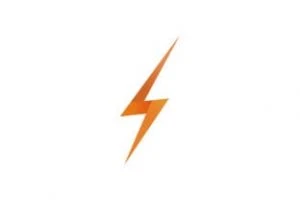
Converting your favourite drive over to electricity seems like a reasonable alternative to buying a brand new EV with a massive price ticket now, doesn’t it? Flicking through the list of brand new EVs that you can currently buy in Australia soon has you eyeing up figures of well over $50 k. At the moment, the cheapest EV in Australia is the MG ZS EV with its $45k price tag. A bog standard Nissan LEAF comes with a drive away price of around $54k. How about a Tesla? Anywhere from $65–93k will get you into a Model 3. Converting an older classic car to full battery-electric power has coolness written all over it. The end result might even gain you a Greta Thunberg award!
Is it possible? Can we convert a favourite oil burner to electric power? If I was to convert my drive to EV, it would have to be a conversion of a favourite car – something like an old Falcon or Commodore. Bringing one of these ideal cruisers up to EV spec would be a challenge, but a challenge with great satisfaction. Installing an electric drivetrain into an old vehicle could help keep some classics on the road and out of the scrapyard. Why not take the restoration, recycling and retrofitting to the next level and repower classic cars?
There have already been a few conversions of this sort of thing in certain areas around the globe, usually in someone’s garage late at night, where the candle burns bright and long into the night. Considering performance enhancements alone, a good off-the-shelf electric drive system will almost always be a substantial performance upgrade for an old daily driver. Even some of the muscle car straight six or V8 powerplants are humbled by a rather conventional EV motor with its instant torque availability.
Converting a petrol or diesel car into an electric one means replacing its combustion engine and fuel system with an electric motor coupled with a traction battery. Although the procedure looks relatively straightforward at first glance, it does mean that you do need to apply sound physics and DIY know-how on electrics to get yourself a car that moves in the right direction safely. There is some pretty high voltage happening beneath the skin of your old, converted classic that enables it to whistle up to 100 km/h in seven seconds, or less. Conversions are a substantial cost and do require appropriate re-certification tickets. However, the whole ordeal should cost quite a lot less than a new EV, at least by a few thousand when compared to a Tesla.
Things to work through.
Installing an electric motor into a gas or diesel car’s chassis and platform requires the skill to build up a drive train and axle to get the power from the electric motor out onto the road. The old gearbox that was essential to the old internal combustion engine (ICE) design is a useless mechanism for the new electric motor. The old gearbox has to go, and a new drive mechanism has to be designed and implemented.
The weight of the vehicle and the dimensions of the wheels directly impact on the choice of brakes and suspension. Not always but, more often than not, the car with a heavy battery pack will weigh more than the original set up. In order to function safely with the added weight and/or changes in weight distribution, the converted car must have some structural strengthening, brake and suspension upgrades and some modifications done in order to ensure that the changes marry up into a harmonious mode of EV transportation and driving pleasure.
The battery pack isn’t going to be cheap. You’ll easily spend in excess of $10–15k for a lithium-ion battery pack that is able to offer a respectable range over 100 km. Lead-acid batteries, like those used in golf carts, can often be installed, though they typically deliver a rather small operating range on one charge. Lithium cells are smaller and lighter, and can enable longer ranges, but they’re more expensive. How many batteries you’ll require will depend on the vehicle you’ve chosen and the space available in which to have them fitted. The new battery pack, as mentioned above, is very heavy and has to be carefully installed inside the car’s framework in a way that won’t compromise occupant space and safety, as well as ensuring excellent on-road behaviour.
One other small thing to think about is how you will heat or cool the cabin. ICE vehicles used the heat that comes from the engine design, but EVs need to run a different set up.
EV enthusiasts usually favour smaller and lighter vehicles for conversion, though the size of your wallet will also control what you can and can’t afford.
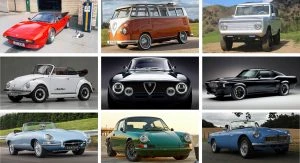
ICE to EV Conversions
Popular choices of cars that have been converted have been cars like the Honda Civic, VW Beetles, the Fiat 124 Spider, the Triumph Spitfire and MGs of the same era, Mazda Miatas or MX-5s, Toyota MR2s, and various Porsches. Pickup trucks and utes are also easy converters because they already have a big tray out the back to accommodate heavy batteries.
Mat Coates from Nelson, NZ, saw the potential of electric cars as a youngster who messed around with remote-controlled vehicles at age 10. His first conversion was a Mitsubishi GTO, so there’s an inspiration for you. How hard can it really be? All things considered, where there’s a will there’s a way. As long as you tick all the boxes and do the job right first time and do it well. A quiet classic that has been converted to EV propulsion is hard to beat and a rather special way of getting around.
A good place to start might also be to talk to the people at https://www.evolutionaustralia.com.au. These people already have experience in converting ICE vehicles over to being an EV.
Hyundai and Hydrogen
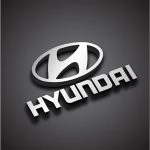
I’m showing my age a bit when I say that I can remember some of the earlier Hyundai cars – the Hyundai Pony and Hyundai Excel come to mind. Back in the 80s and early 90s, Hyundai cars were light, comfortable, and not really up to the same safety standards as the cars that were produced in other parts of the world. Nowadays, however, the story is completely different, and the South Korean automaker often tops crash safety tests with their vehicles, the vehicles are still comfortable, and the style and technology has won many awards. Hyundai has been always improving to the point where they are now a premium brand, very desirable, and leading the world on many fronts. Key new innovations from the Hyundai Motor Company (HMC) team are exciting and are part of Hyundai’s vision for building a cleaner, greener world that includes vehicles that no longer rely on fossil fuels.
Because of the past couple of years, where covid has taken the world’s centre stage, there has been a big shortage of semiconductors in the auto industry, to the point that some auto manufacturers have had to shut down. Semiconductors are used in the manufacture of electronic devices, including diodes, transistors, and integrated circuits. These devices have a wide application in anything electronic, including laptops, computers, appliances, and, of course, the modern automobile.
Like all vehicle manufacturers, HMC has been affected by the shortage and have had to temporarily suspend some of their factories. Despite the shortage, however, along with Toyota and Tesla, Hyundai is among a handful of automakers that actually increased their global sales despite the chip shortage.
However, Hyundai now plans to develop and build its own semiconductors so that they are not so reliant on chipmakers from other corners of the globe. Hyundai wants to make sure it has a steady supply of semiconductors for their projects on-and-into the future by making its own. It will be the parts and service arm for Hyundai, Kia and Genesis who would play a key role in the in-house development. Stockpiling the electronic chips would be important for Hyundai, so that when other global crisis occur, they will then be in a better position to weather the storm. Toyota and Tesla have already had stockpile contingency plans in place for some time, which has ensured that they fared well during covid.
Hyundai and Hydrogen
Hyundai are part of the Hydrogen Heavy Duty Vehicle Industry Group – comprised of hydrogen industry leaders Air Liquide, Hyundai, Nel Hydrogen, Nikola Corporation, Shell and Toyota. This Group has signed agreements with Tatsuno Corporation and Transfer Oil S.p.A. to industrialize globally-standard 70 MPa hydrogen heavy-duty vehicle high-flow (H70HF) fuelling hardware componentry. But, also, in Incheon, which is just west of Seoul, and in Ulsan, production plants will begin producing the hardware in the 2nd half of 2023 with an annual capacity of 100,000 hydrogen fuel cell systems.
South Korea’s influence on core Hydrogen components will see it as the world’s largest fuel cell production capacity, which will also help the HMC to diversify their business and tap into construction machinery and logistics equipment.
EVs might be the big talking point for some, but it is hydrogen that is the dark horse in the clean-green race. These two new fuel cell plants in Korea will accelerate the hydrogen economy and secure broader global market dominance. I reckon that Australia could be a hub for Hydrogen in the Pacific, don’t you think?
Hyundai’s wide-ranging hydrogen revolution accelerates with the showing of their 500 kW Vision FK sports car prototype and the e-Bogie autonomous commercial transport vehicles. HMG recently announced that it will launch next-generation hydrogen fuel-cell power units in 2023 that will double the power output, halve the cost, and reduce package size by 30%, when compared to current systems. Hyundai has a plan to offer “hydrogen for all” by 2040.
Hyundai’s Hydrogen Timeframe
In case you were not already aware, HMG is the parent of Hyundai, Kia and Genesis. By 2028, HMG says it will have applied fuel-cell systems to all of its heavy commercial vehicle models, including large trucks, significantly reducing transport-related CO2 emissions.
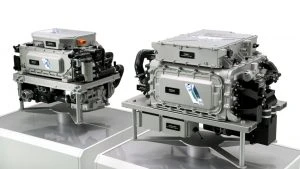
Hydrogen Fuel Cells
By 2030, Fuel-Cell Electric Vehicles (FCEV) will have achieved price parity with Battery Electric Vehicles (BEV), HMG says. And by 2040, HMG expects hydrogen to be available for everyone, for all vehicle types, and globally, triggering a lifestyle revolution.
Models for the Future
The Vision FK sports car is a 500 kW, hydrogen-powered high-performance prototype coupe that is capable of accelerating from 0-100 km/h in less than 4 seconds, while still offering a range of 600 km between top ups. The Vision FK’s fuel cell unit carries N Performance branding, suggesting that it would be a future Hyundai N model rather than a luxury-focused Genesis. HMG’s head of R&D, Albert Biermann, would not be drawn on when the Vision FK would go from prototype to production, but he did confirm that the next-generation Nexo fuel-cell SUV will launch “in the second half of 2023 followed by a Staria” The Staria is a people mover recently launched in Australia. “We are also working, of course, on fuel-cell cars for Kia and Genesis. That will take a little longer time. After 2025 you can expect further fuel cell applications.”
The e-Bogie commercial application is a fuel-cell-powered autonomous trailer that could revolutionise commercial transportation. Biermann also stated, “We are working full throttle on commercial [first] because that is the most effective way to avoid CO2. We are putting a lot of focus on fuel cells, not only for passenger cars but also for commercial vehicles.”
HMG’s Chairman, Euisun Chung, is even more emphatic about the significance of hydrogen fuel cell applications toward a sustainable future. “This may be the last train to a Hydrogen Society, and time is running out. Hydrogen is the most powerful and pragmatic solution to overcoming environmental challenges. Hydrogen mobility will accelerate human progress.”
He went on to say that Australia may have a role to play. “We know Australia is a country with vast and abundant renewable energy. We are exploring business opportunities in Australia with our partners. Our goal is to build a sustainable ecosystem for [a] global hydrogen society.”
He also said that, “We will not immediately phase out internal combustion engines (ICE) commercial vehicles, but we are not starting any new developments of ICE. No new models and no new platforms. Everything will go forward with BEVs and FCEVs.”
Interestingly, according to Hyundai’s head of fuel cell development, Mr Saehoon Kim, FCEV technology has one huge advantage over BEVs: “The main problem with [a] BEV is the scalability of batteries. For a small EV it’s okay, but for commercial large scale [operation] the question immediately is …. How are we going to stack all these batteries with the heavy weight, and who is going to be happy with the low range? So, in this case fuel cell fits perfectly.”
Hyundai’s heavy commercial fuel cell program is already well advanced. In mid-2020, 45 Hyundai Xcient fuel cell trucks began commercial operation in Switzerland. Biermann stated that the trucks covered 210,000 kilometres per month and have saved 130 tonnes of CO2 emissions every month in operation.
The key to Hyundai’s commercial strategy is its third-generation fuel-cell system, which is in the final stages of development. Hyundai expects to launch two units in 2023, one producing 100 kW for passenger vehicles and SUVs (including the next Nexo and Staria FCEVs), and a 200 kW unit for commercial applications. It has been said that by using two fuel-cell systems for trucks Hyundai can provide around 350 kW, which is equivalent to the power of current diesel engines used in trucking logistics.
This is all very exciting news and one that I have welcomed hearing. I’m a fan of the new hydrogen fuel-celled vehicle technology moving forward. This is Hyundai at its best, and we can only continue to watch this space.
Current Hyundai achievements:
The current ICE Hyundai i20 N has been crowned champion of Top Gear’s Speed Week. The 26 fastest cars in the world participated in Top Gear’s Speed Week 2021. It was the Hyundai· i20 N’s sharp handling and everyday usability that stood out to those in the Top Gear team.
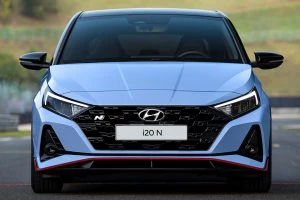
Hyundai i20N
Ford Movements
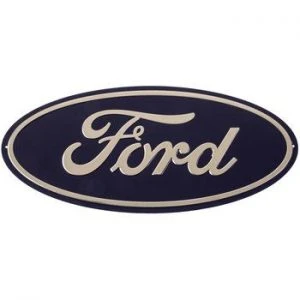
Hot off the Press News has Ford investing big money in EV production. All up, Ford and a South Korean supplier will spend $11.4 billion US on Ford’s EV production and expansion. Ford hopes this spend will enable them to produce more than one million EVs per year in the second half of this decade. The buzz words used in new and future cars include the term electric vehicles or EVs. Established automakers like Ford are racing to try and close the gap on Tesla’s EV lead. As you may be aware, Tesla produces a range of EVs, and Tesla are currently on the way to selling more than 800,000 electric cars this year. Tesla is currently the most valuable automaker in the world, with a market capitalization of nearly $800 billion US. Ford’s market value is $56 billion US.

Ford F-150 Lightening
Ford’s big spend will be its 2nd biggest spend in its history. Under the climate change banner and the Biden government, this latest US multibillion-dollar move to quickly transfer production plants to EV production is seen as a fast track phasing out of gasoline-powered cars and trucks as part of the global push to combat climate change. I won’t debate the science here.
Ford is to build 2 battery plants in Kentucky and 1 in Tennessee under the joint venture with its main battery cell supplier, SK Innovation of South Korea. In addition, Ford will build an assembly plant at the Tennessee location to churn out EV trucks. Ford will invest $7 billion and SK Innovation $4.4 billion, the companies have said. Ford expects electric vehicle models to make up 40% of their vehicle production by 2030. That’s only a little over 8 years away!
Ford’s new truck plant and battery factory in Tennessee is likely to be the place that will produce a new battery-powered Ford F-Series pickup truck, this following the previously announced F-150 Lightning pick up truck. I have to say that the F-150 Lightening is an impressive beast! Ford has said a mix of both the public and businesses had already placed 150,000 reservations for purchasing the F-150 Lightning.
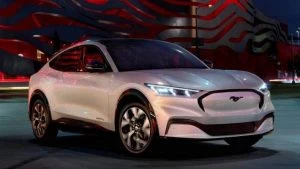
Ford Mustang Mach-E
Also this year, Ford began selling the Mustang Mach-E, which has taken a sizable market share from Tesla. Ford also plans to add an EV delivery van into the mix by the end of the year. Then, in early 2022, the electric F-150 Lightning will roll out of their showrooms and silently onto the tarmac.
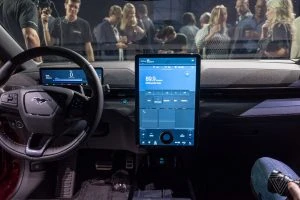
Ford Mustang Mach-E
Mr. Jim Farley, Ford Motor’s president and CEO, has recently said that making electrical vehicles affordable should be among the top priorities for automakers, so that the average vehicle-buyer can purchase one. This is good news, as a new EV is well out of most people’s budget.
He also made a couple of rather poignant comments: one on a key issue on questioning how EV production will impact labour/jobs (a subject rather close to home with our relatively recent Ford and Holden closures), and the other on materials. So, apparently, it costs 30% less to manufacture the Ford electrical vehicles. This will definitely affect production rates and employment long term. Then there is also the issue of battery supply and the rare minerals (i.e., lithium, cobalt) needed to power them, said Farley. Mr Farley stated, “We have to bring battery production here, but the supply chain has to go all the way to the mines. That’s where the real cost is, and people in the U.S. don’t want mining in their neighbourhoods. So, are we going to import lithium and pull cobalt from nation-states that have child labour and all sorts of corruption, or are we going to get serious about mining? … We have to solve these things and we don’t have much time.”
Here in Australia, we haven’t jumped on the EV wagon just yet, and if we are going too, then there is so much infrastructure that will be needed to be implemented before owning an EV becomes a viable option for people like me. Even the thought of the costs involved in getting the right infrastructure is eyewatering, and, like most impatient home renovators and idealistic politicians, the job must be done yesterday! The hard working folk pay for it, of course!
There seems little patience on offer by many governments and climate change activists for making the move to EVs (and other new transportation technology like an EV repower on your existing car) a more balanced and delicate affair. For now, owning an EV is very much for the elite, so Farley is on the right track when he says that the cost of EV ownership must be addressed very quickly.
Ford still has many plants throughout the U.S. However, like other big automotive manufacturers, Ford also has locations right around the world. Ford has many production plants scattered about the globe, and these include assembly plants, engine plants, forging plants, stamping plants and transmission plants. Here, in Australia, Ford still has special engine production and stamping plants.
On a more local note, Ford has a new feature called ‘FordPass’ offered on all their new models sold in Australia. FordPass has a few systems worthy of a mention that include:
Remote Start+, where minutes before leaving, you can start your connected vehicle’s engine from your mobile device in order to heat or cool the cabin using the last known climate control setting.
Vehicle Status, where you can check key variables such as fuel level and your odometer on the FordPass App to help plan your journey.
Remote Lock/Unlock, where, conveniently, you can use your mobile device to make sure the car doors are locked or unlocked without being anywhere near your vehicle. If only it could do that for my house front door!
Vehicle Locator, where you can check your vehicle’s exact location in the FordPass App, which is particularly useful if you share your vehicle with one or more members of your household or if you have forgotten where you parked it. However, if you’ve forgotten where you’ve parked it, then maybe you better get breath tested!
Vehicle Health Alerts, where the FordPass App sends Vehicle Health Alerts directly to your mobile device, pre-empting service needs and general maintenance such as low washer fluid.
Live Traffic, where this feature enhances your SYNC 3 Navigation system by delivering up-to-date traffic updates. This technology allows you to adjust your recommended route based on the traffic conditions, helping you to arrive more relaxed and on time.
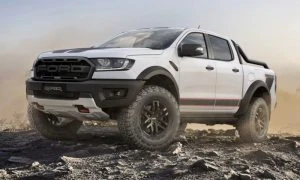
Ford Ranger Special Ediiton
In this second half of 2021, Ford Australia offer a nice broad range of vehicles that include the Puma, Escape and Everest SUVs; the Ford Focus car; the Ford Ranger Ute; the Transit Commercial range that has custom vehicles, vans, buses and cab-chassis models; the Ford Performance range that includes the Fiesta and Focus ST, the Focus ST-3, the Ranger Raptor, the Mustang and Mustang Mach-1; and the Special Edition Rangers and Everests.
It is good to see Ford keeping pace with any EV and hybrid automotive technology and movements; though at what societal and environmental cost? New Ford vehicles are good, and Ford offers a very complete package for all new vehicles in the Ford range. Once you’ve driven a Ford, its not so easy to change out of the brand come new car buying territory.
BMW Brilliance

BMW has always been a favourite standout brand of mine, and BMW is forging new models and technology even as we speak. It has been a bit of a gruelling year-or-two with the covid shenanigans, and car manufactures are only one small segment of the global economic pie to have taken a sizable hit. The shortage of semiconductors has been, and still is, a problem because cars rely on these items for controlling anything from your electric windows to all the fancy driving assistance aids. However, the winds are changing, and the rebound is occurring. Luxury car marques like BMW seem to be doing very well, and even with the electronic chip shortages being a bit of an issue it seems that BMW will get through this period in fairly good shape. There is always a talking point re this special car marque; sometimes the designs might look great to some and not so flash for others, but there is always a gem being turned out from this great team of motoring designers and manufacturers. BMW cars are more often than not great to drive, good looking, practical and advanced cars.
In this covid recovery period, various chief financial officers recently mentioned that, for now, luxury marques like BMW would consciously undersupply demand levels, which seems a prudent, sensible path to take, as BMW new car prices are holding up very well – quite bullish in fact. The increased pricing power has already trickled down to the bottom lines for BMW and Daimler. Mercedes achieved a 12.2% return on sales in the last reported quarter, which was up from 8.4% in the same period in 2018 (2018 being of a period not affected by the pandemic or diesel emissions litigation costs). BMW achieved a 16% return on sales, which was up from 8.6% in 2018. BMW also reported a $5.7 billion net profit in the second quarter of this year, suggesting global auto markets are continuing to recover from the pandemic — particularly when it comes to luxury cars like BMW and Mercedes.
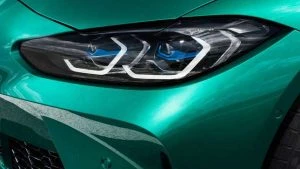
BMW M4 Minty Green
This is great news for BMW and car lovers in general, but what’s new in BMW’s box of tricks? A very cool thing that BMW revealed at the recent Munich Motorshow (early September 2021) was to be found in the BMW M4 corner, where this manic machine, with its impetuous acceleration, showed a jaw-dropping minty green sheen to its beautiful, sexy exterior. The M4 Competition wore a Mint Green paint job and sat upon gorgeous bronze 20-inch rims. Both of these options are available as part of the brand’s expanded BMW Individual customization line, which you can find on BMW’s online configurator, where more than 130 other paint options and eight different wheel options are available. This latest BMW M4 Competition also had a new fibre front splitter, a restyled rear bumper, a rear wing, and some unique side skirts that were all made with carbon fibre. Carbon fibre interior seating surfaces and trim pieces are also part of the online configurator. So, try before you buy!
The Munich motor show also allowed the public to preview a hydrogen-electric BMW X5 that is due to enter very-limited production in 2022. This is an exciting moment because the vehicle was first previewed in 2019 as the i Hydrogen Next concept. It’s currently in the prototype stage, and early this month it was confirmed with the go ahead, going by the name of BMW iX5 Hydrogen.

A hydrogen-electric vehicle is like a battery-electric vehicle, but instead of drawing power from electricity out of the charged battery the hydrogen-electric vehicle relies on a hydrogen fuel-cell stack to produce electricity power. BMW’s iX5 Hydrogen has the hydrogen fuel-cell positioned up front where it draws hydrogen from 2 tanks, one in the X5’s transmission tunnel and another under the rear seats. The tanks are made from carbon-fibre-reinforced-plastic and can hold about 5.9 kg of hydrogen at more than 10,000 psi. Tank filling takes only a few minutes. The hydrogen fuel-cell combines hydrogen with oxygen from the air to create electricity. This process only has water (H2O) as a by-product – Wow! The electricity primarily powers a single motor at the rear axle but is also used to charge a small battery that steps in from time-to-time to deliver extra grunt to the motor during high-load situations.

BMW iX5 Hydrogen Platform
The BMW iX5 Hydrogen will have a total system power output of 275 kW. The hydrogen fuel cell, on its own, generates about 125 kW. The vehicle’s aerodynamically shaped 22-inch wheels are wrapped in a new Pirelli tyre that is made from natural rubber and a wood-based synthetic fibre known as rayon. These two materials replace much of the petroleum-based synthetic rubbers used in modern tyres.
The extensive field testing has already started in earnest within Europe. Particular focus points have had the engineers examining how effectively the CO2-free drivetrain works in real-life conditions. Also, they are measuring metrics which include reliability, safety, and efficiency during everyday conditions to ensure that the new model is perfect for mass production. Hydrogen fuel cell technology has the potential to supplement internal combustion engines, plug-in hybrid systems, and battery-electric vehicles. The BMW iX5 Hydrogen has hydrogen tanks that can be filled quickly in only 3–4 minutes.
BMW states that the small batch of iX5 Hydrogen models that are destined to be built in 2022 will only be used for demonstration and testing purposes. BMW doesn’t expect to have any hydrogen-electric vehicles at dealerships until 2025 at the earliest and depending on the direction that the automotive markets take.
Newest off the showroom floor is the all-new BMW iX3 with its refreshed exterior design. The new BMW iX3 has a sexier appearance and introduces the M Sport Package as standard. BMW has achieved an impressive CO2 emission assessment for this next-generation iX3, and the vehicle boasts an exceptionally efficient drive system. Extensive use of secondary raw materials in the manufacture of aluminium castings and thermoplastics combines with the new iX3 boasting an absence of rare earth materials and the use of more green electricity in its production.
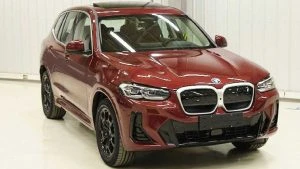
BMW iX3 2022
The BMW iX3 has a kidney grille that is larger still, and it has a single-piece frame that comes in Pearl-effect Chrome with blue accents to match with the BMW i styling cues. Its headlights have been made slimmer. It also boasts 19-inch black aerodynamic wheels, an automatic tailgate, adaptive suspension, a heated steering wheel, a panoramic sunroof, and Smartphone integration with Apple CarPlay and Android Auto.
BMW is a bit of a landmark in the automotive world, a benchmark, the perfect blend of performance, luxury and practicality. In the future, BMW wants to be ready to supply customers with their powertrain of choice, whether it be gasoline, diesel, battery or hydrogen. In the case of hydrogen, BMW sees it as an opportunity for customers that favour long-distance driving or who happen to live in regions without adequate battery recharging infrastructure.
I have so many favourite BMWs and other cars, including the 4.0-litre Falcons, which have rolled our roads over the last few decades of motoring, but let’s not be nincompoops and let’s embrace new ways of automotive power; let’s embrace the new BMW i technology.